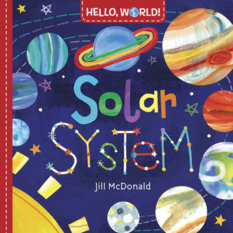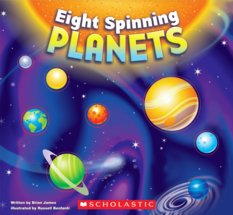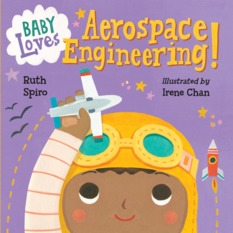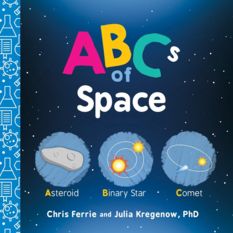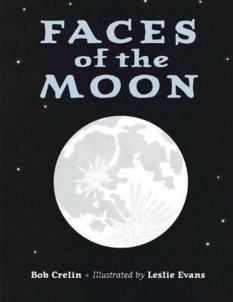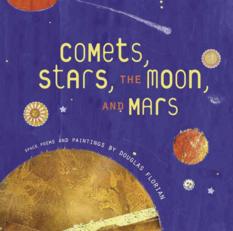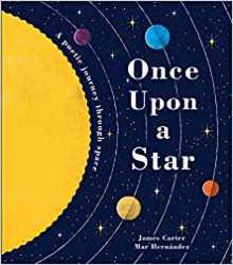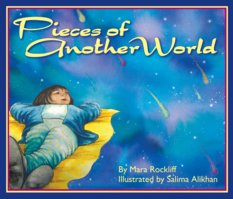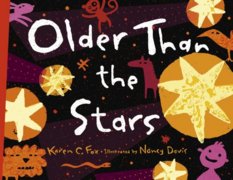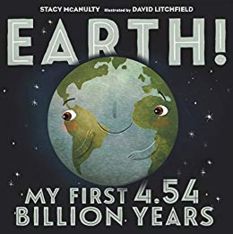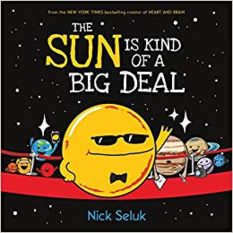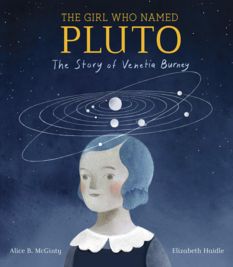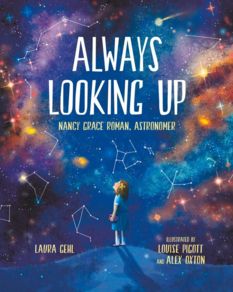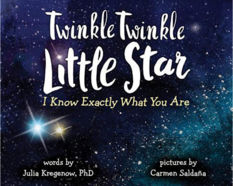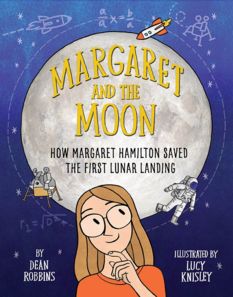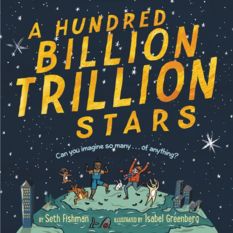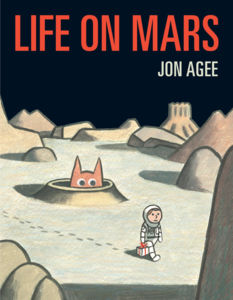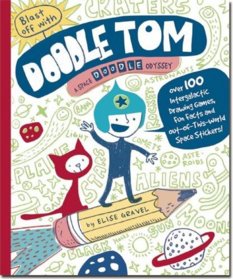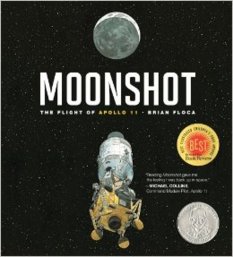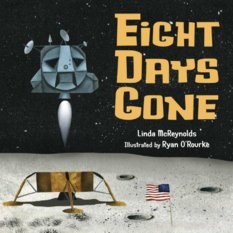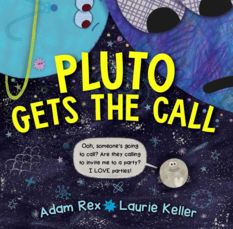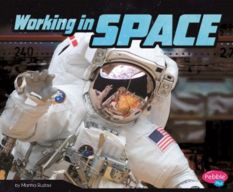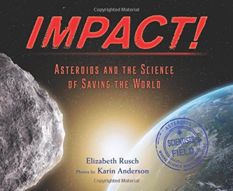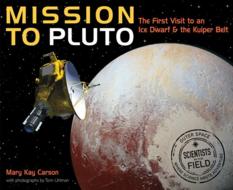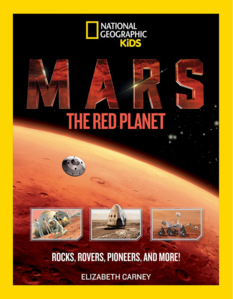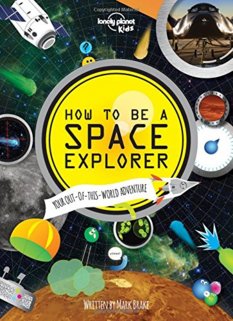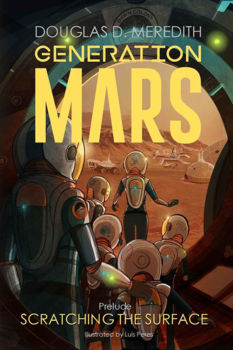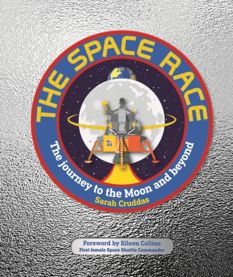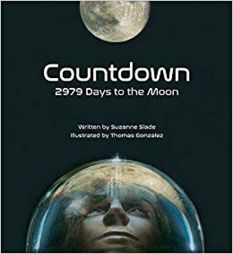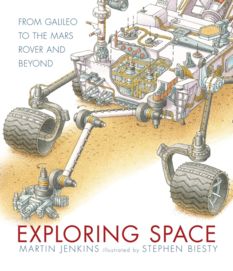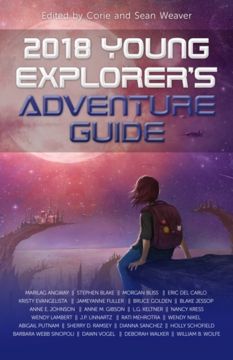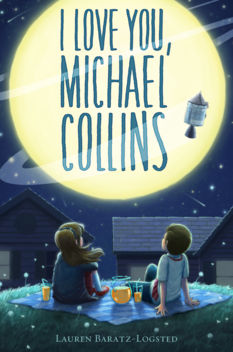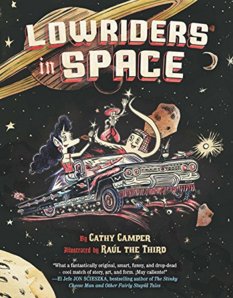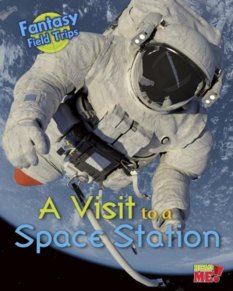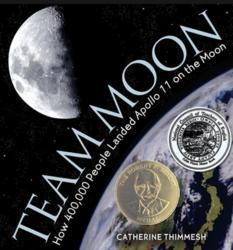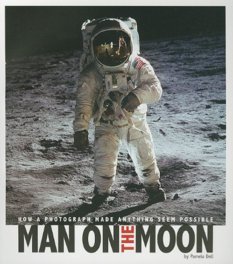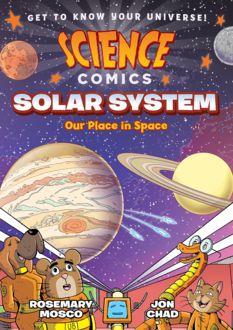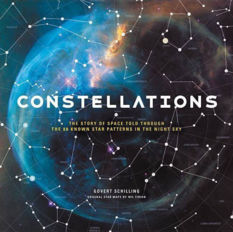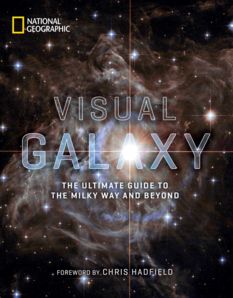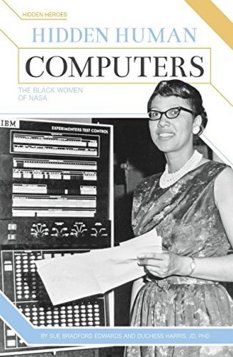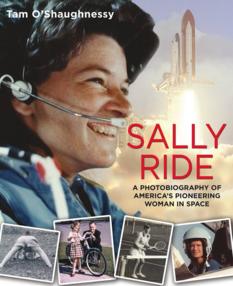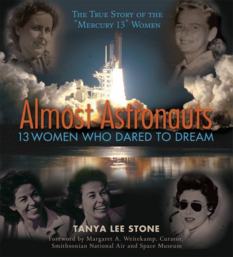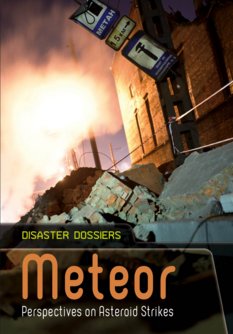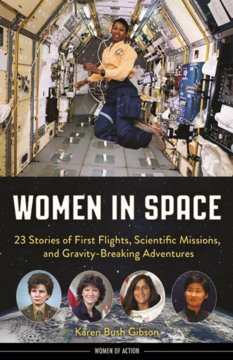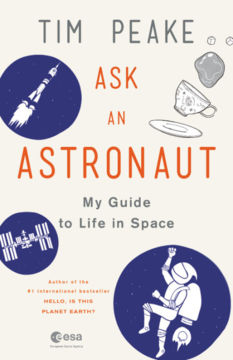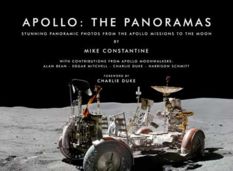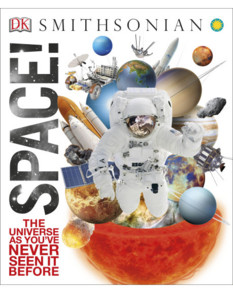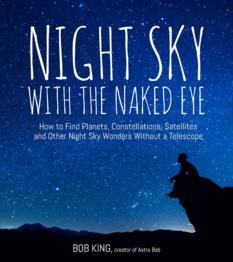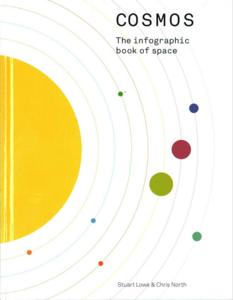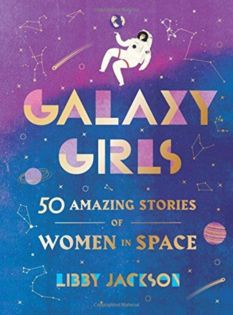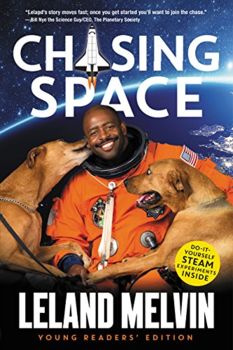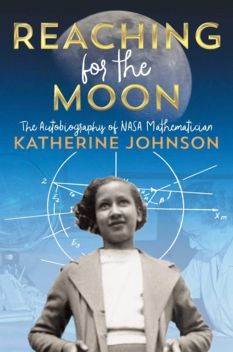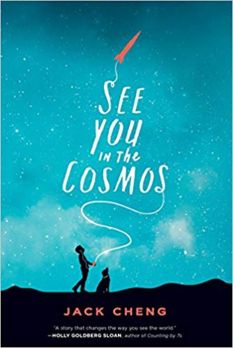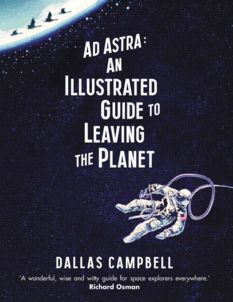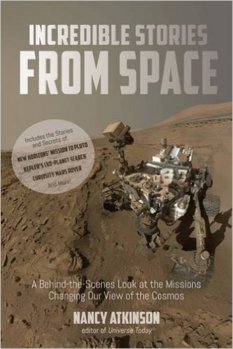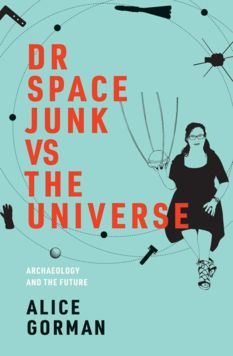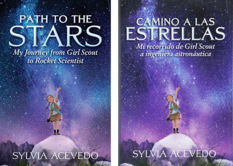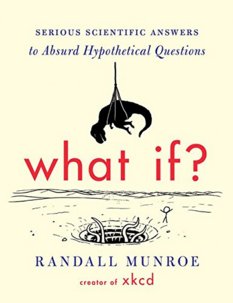Emily Lakdawalla's Recommended Kids' Space Books
Every year, The Planetary Society's Senior Editor and Planetary Evangelist Emily Lakdawalla reviews recently published space-themed books for kids of all ages. The 2019 book reviews are posted here. This page is a collection of Emily's favorite books that are still worth buying for your favorite children or libraries.
Books for preschoolers, age 0-3
Touch the Brightest Star
By Christie Matheson
This is my new favorite bedtime or naptime book for babies and toddlers. Each page has a little action: "First wave good-bye to the sun's bright light. / Gently press the firefly. / Oh! Press again to light up the sky." Turn the page, and fireflies are everywhere! Meanwhile, as actions and words take you from page to page, the sky behind the illustrations goes red, then aqua, then blue, then darker, and stars come out (including Big and Little Dippers and a comet), then "Close your eyes and breathe in deeply. / Nod your head if you feel sleepy." It's gentle and lovely.
Hello, World! Solar System
By Jill McDonald
Solar System is a good baby board book with colorful paintings of planets. It doesn't have annoying singsong rhyme, so can be read over and over without pain. It invites the toddler to point at one planet, trace Saturn's rings with a finger, and finishes with a panorama of all the planets, asking baby "Where would you like to go first?" Pluto fans, rejoice: Pluto is included, with no aspersions cast on its character.
Eight Spinning Planets
By Brian James, Illustrated by Russell Benfanti
Eight Spinning Planets is a large board book, with each planet represented as a round plastic shape protruding through die-cut circles in the pages; as you turn each page, one planet at a time disappears until, on the last page, you're out at Neptune. The text is in rhyming couplets: "Eight spinning planets travel round the sun./Mercury is closest and is the smallest one." There are two couplets on each page, and the way they are written, you can choose to read only the first couplet and the book still rhymes and makes sense -- something that any parent of a toddler who likes to turn the pages too fast will appreciate. Each page also has a photo from each planet and a short sentence about it, some of which are much better than others, but these were pretty much ignored by my toddler. The main strike against this book is the final couplet, which is wrong in a couple of ways: "We've counted all the planets circling the sun. That leaves only Pluto, which is too small to be one." I've been working on a substitute final sentence for the book, but haven't come up with a good one yet. Overall, though, I recommend the book; reading it has taught my younger daughter the names of the planets and their order from the Sun.
Baby Loves Aerospace Engineering!
By Ruth Spiro, illustrated by Irene Chan
It's a relief to have one baby space book to recommend that does not just list all the planets. This adorable baby board book talks about how Bird can fly, then asks if airplanes fly like birds? (No!) But at least Bird can commiserate with the airplane that neither can go to space. In the end, the bird gets to take a rocket into space. Have fun, bird!
ABCs of Space
By Chris Ferrie and Julia Kregenow
A good gift for a space fan with a newborn, this book isn’t intended for babies, but it provides parents something interesting and educational to read in colorful board-book format while giving the baby the experience of being read to. Each page covers one letter of the alphabet, from Asteroid to Zenith, and includes a one-sentence definition: “I is for Inflation. Inflation was the very rapid expansion of the universe shortly before the big bang.” Another paragraph with more detailed explanation follows.
Books for young children, age 4-7
Faces of the Moon
By Bob Crelin
Among my daughter Anahita's earliest words was "Moon." She'd point it out in the sky whenever she saw it, which wasn't usually at night; it was usually in the morning or evening when we were out and about. But sometime during the last year, popular culture (or toddler culture, anyway) has "taught" her that the Moon is out only at night. Failing to find a book appropriate for preschoolers that discussed the Moon's phases and the fact that it can be seen in the daytime too, I even considered writing one myself. Now I don't have to, because Bob Crelin has done it, and done it admirably, in Faces of the Moon. The book is written in verse and has beautiful, bold, block-printed illustrations by Leslie Evans that will appeal to young children, but the concepts it teaches work well for older children (and even adults). As the verse defines "new," "crescent," "quarter," "gibbous," "wax," and "Wane," cutouts in the pages cleverly show only as much of the Moon as is visible during each phase; along with tabbed page edges, the book's design helps to hold the attention of younger kids. The quality of the verse is way above the average for educational kids' books. For example: "A few days pass, and Moon's less shy;/ her smile lights the twilight sky./ The more her sunlit surface shows, the more Moon's WAXING CRESCENT grows."
Comets, Stars, the Moon, and Mars
By Douglas Florian
Short, cute poems about each of the planets and other objects in space have an almost Shel Silverstein-like rhythm to them. They are accompanied by brightly colored, witty collage illustrations that have the same spirit as the poetry. As with any poetry collection, some are better than others, but several made me laugh outright, such as "Pluto was a planet. / But now it doesn't pass. / Pluto was a planet. / They say it's lacking mass. / Pluto was a planet. / Pluto was admired. / Pluto was a planet. / Till one day it got fired." I think the book is suitable for kids down to age 3 or 4. It'd be an excellent resource for teaching poetry or collage in a language or visual arts class, and sneak in a little science!
Once Upon a Star
by James Carter, illustrated by Mar Hernández
I couldn’t help but read this book aloud to myself from the first page. The poetry is enjoyable; the typography guides the reader to speak strong words with appropriate emphasis, and longer lines lyrically. All the while, it tells the story of where we came from -- the Big Bang, our Sun, our nebula, our planet. There’s not a lot of detail; this is a fable, told in rhyme, for young children, and it’s beautiful.
Dogs in Space
By Nancy Coffelt
Dogs in Space is long out of print, but it's available used and is one of my favorite books to read aloud to young children. Richly colored pastel-drawn dogs "blast off from Planet Earth for a solar system tour." They journey in turn to each of the planets, finding something not quite hospitable on each one ("Ah-choo! Dogs in space sneeze red dust on the planet Mars.") Having traveled to Pluto, they reflect on the things they like about space (for instance, "There are no cats in space.") But they miss warm laps and dog bones so they return to planet Earth, "for now."
Pieces of Another World
By Mara Rockliff, illustrated by Salima Alikhan
This is such a sweet story. A child is woken from sleep in the middle of the night by a father who promises to show her the titular "pieces of another world." The child sees her own world at night for the first time, both her urban world (empty grocery store, busy all-night restaurant) and her natural world (nocturnal wildlife). Finally, she sees the promised other worlds, which you and I knew all along were meteors, but which may be a surprise to young kids being read this story. This book would be a super way to prepare kids for their first trip with you to watch a meteor shower.
Older Than the Stars
By Karen C. Fox, illustrated by Nancy Davis
This is a book about Big Bang cosmology, solar system formation, and human evolution for young children. It's hard to imagine that such a thing could succeed, but it does. The main text is a repetitive, singsongy, catchy rhyme in the spirit of the traditional "house that Jack built" poem. The rhyme is really fun to read aloud, and a reasonably factual account of the scientific "creation story" accompanied by quirky, brightly colored graphics, with text incorporated into the artwork traveling in topsy-turvy directions, so it's a success for my preschooler.
Earth! My First 4.54 Billion Years
by Stacy McAnulty, illustrated by David Litchfield
“Hi, I’m Earth! But you can call me Planet Awesome.” In this adorable story, narrated by the awesomest planet, Earth introduces itself and its family (eight siblings and billions of cousins), shows baby pictures (including its “explosive” and “gassy” babyhood), and talks in a light and fun way about the forces that have shaped its surface over the titular 4.54 billion years. It’s a wonderful read-aloud book to teach young kids about writing personal narratives and Earth history simultaneously.
The Sun Is Kind of a Big Deal
by Nick Seluk
Nick Seluk is the cartoonist behind the Awkward Yeti and Heart and Brain comics, which my children adore, and he’s also a space geek. His latest book is aimed at a younger audience than his usual comics. The text is a straightforward nonfiction work about the Sun -- its size, position, and all the things that it does for us on Earth. Seluk’s humor shows up in the word bubbles spoken by all the planets, making it a cute and funny read. I know how I’d read this book if my kids were still into being read to -- I’d read the text, and the kids would read and voice the planets!
The Girl Who Named Pluto: The Story of Venetia Burney
By Alice B McGinty, illustrated by Elizabeth Haidle
This lovely book explains how a little girl’s love of mythology and asking questions inspired her to suggest the perfect name for Pluto, and how family connections helped deliver her suggestion to the Royal Astronomical Society and ultimately Clyde Tombaugh. It is mostly based on true events and ends with the story of an elderly Venetia Burney Phair seeing Pluto through the eyepiece of a telescope for the first time. It’s a gentle story, told in present tense, the language enjoyable to read aloud.
Always Looking Up: Nancy Grace Roman, Astronomer
By Laura Gehl, illustrated by Louise Pigott and Alex Oxton
Always Looking Up is an excellent biography of an excellent woman. Roman was remarkable for overcoming sexism to become an astronomer and for her pioneering research, for starters. However, as the book makes clear, her greatest accomplishments were in the realm of service to the astronomy community, and I don’t believe I’ve read a children’s book about that before. It talks about her traveling to the Soviet Union for scientific exchange during the Cold War, about becoming the chief of astronomy at NASA, and of course, about her role as the mother of the Hubble Space Telescope. “Nancy Grace’s passion shone as she spoke,” Gehl writes. “She had seen and learned so much in her career already. Now she could share that knowledge with others.”
Twinkle Twinkle Little Star: I Know Exactly What You Are
By Julia Kregenow, illustrated by Carmen Saldaña
“Opaque ball of hot dense gas, million times our planet’s mass, looking small because you’re far, I know exactly what you are.” I set a high bar for “Twinkle, twinkle” poetry: it needs to toe the line on meter, not squeezing in awkward extra syllables or torturing grammar. I’m happy to say that this book meets that bar and is delightful to read aloud. It teaches about different types of stars and goes on to black holes and galaxies before returning home.
Margaret and the Moon: How Margaret Hamilton Saved the First Lunar Landing
By Dean Robbins, illustrated by Lucy Knisley
Margaret and the Moon is one of those wonderful books that presents as a picture book for young children but which has plenty to teach older readers. It's a succinct biography of the pioneering software engineer whose code enabled the success of the lunar landings. Along the way, it even manages to deliver terse summaries of different branches of mathematics. ("She liked moving around x's and y's in algebra. She liked measuring circles and triangles in geometry. She liked studying curves in calculus.") My only quibble is that in the climax of the story, so much credit is given to Hamilton that it suggests her software alone saved the day, without mention of Buzz Aldrin's steady hand on the controls. But nearly every book about Apollo 11 makes the reverse omission, and I'm happy to see Hamilton get her day.
You Are the First Kid on Mars
By Patrick O'Brien
This terrific book, told in the second person, asks "Would you like to go to Mars?" Then it takes you, the reader, up a space elevator, to a space station, to a space ship, to another station, and down to a habitat on Mars' surface, where you see how scientists and engineers use robots to maintain their colony, explore the world, and search for microscopic life. By addressing his audience so directly, O'Brien effectively pulls the reader -- or kid listening to the story -- into this imagined future. O'Brien's 42 paintings are fully realized concepts of future technology and have a dimensional reality that adds to the immersive feel of the book.
The Darkest Dark
By Chris Hadfield, illustrated by the Fan brothers
A parable about a would-be astronaut discovering the inner strength to overcome his fear of the monsters that hide in the dark, and discovering that the dark also harbors dreams. It's funny, heartfelt, and awe-inspiring, and a terrific book to read aloud.
A Hundred Billion Trillion Stars
By Seth Fishman, illustrated by Isabel Greenberg
A delightful book to read aloud to children who are thrilled by the sound of immense numbers, like ten quadrillion (the number of ants living on Earth, which together weigh the same as the seven billion five hundred million humans on Earth, according to Fishman). It's illustrated in a deceptively simple, colorful style that's easy to see from a distance -- a perfect library read-aloud book. Don't miss the author's note at the end, in which he explains a little bit about estimating such large, round numbers.
Life on Mars
By Jon Agee
Yet another delightful read-aloud book. An astronaut goes to Mars to search for life. He or she (it's narrated in the first person, so not specified) even brought cupcakes to share. But everywhere they look, they can't find life. The kids to whom you're reading the book will yell and shout at point at the enormous curious orange alien that the astronaut is missing! It's silly fun but, for those of us engaged in the search for life elsewhere, it's an important point that we can only find life where we look for it.
Blast off with Doodle Tom
By Elise Gravel
Blast off with Doodle Tom is an activity book, in the spirit of the "Anti-coloring books." It's printed with stories and facts on each left page and, on the facing page, a large frame of blank space with a drawing idea, e.g.: "Draw your very own Martian"; "Draw new undiscovered planets and give them funny names"; and, on a page randomly studded with dots, "Create new constellations by linking stars." There are two large sheets of cartoony space stickers in the back. My six-year-old dove straight into this one with her pencil. Kids will have to be able to read fairly well to be able to understand the prompts.
Moonshot: The Flight of Apollo 11
By Brian Floca
Moonshot relives the dramatic adventure of the Apollo 11 mission to the Moon. The text consists of spare, tight blank verse that somehow manages to thrill the heart as it economizes on words, while the pen-and-ink illustrations evoke the adventures of superheroes in graphic novels. I am too young to have been one of the millions on Earth who were glued to their televisions for those dramatic days in 1969, but while reading Moonshot I felt a little of the excitement and fear that the people back home must have felt as they listened to the crackly reports of the astronauts coming across the airwaves. The book doesn't just have this effect on humble space enthusiasts; astronaut Michael Collins says in a blurb on the book's cover that "Reading Moonshot gave me the feeling I was back up in space." Although the text is spare, short, and evocative, the sentence structure and vocabulary are a bit advanced for the younger end of the cited age range. I think the publisher does a disservice to the book by stipulating the upper appropriate age as eight; the way that this book so effectively stirs the emotions of the reader, and the graphic-novel style of its illustrations, should appeal to much older kids. Although it's a picture book, it doesn't feel like a kids' book -- it feels almost like the storyboard for a movie.
Eight Days Gone
By Linda McReynolds, illustrated by Ryan O'Rourke
This is another curious story book about Apollo 11. It would appear to be intended for very young children; the illustrations are stylized, and the text consists of very sparse couplets. Few pages have more than ten words. But read the text and you'll realize you're not reading baby singsong verse; this is poetry. "Edwin Aldrin hops around. / Boot prints left on ashen ground. / Desolation. Silent. Dark. / Tranquil sea. Barren. Stark." Eight Days Gone is a pleasure to read aloud to young children. They may not understand all the words, but the words are mellifluous ones. After all, the story -- a trip to the Moon and back -- is straightforward to understand from the illustrations, while the lovely words provide a sense of the strange and new.
Pluto Gets the Call
By Adam Rex, illustrated by Laurie Keller
Back when New Horizons flew past Pluto, I had the idea to write an educational children’s story from Pluto’s point of view about how Pluto felt upon “demotion” and then found a place to belong among the wonderful new worlds of the Kuiper belt. It turns out I wasn’t the only one with this idea; I had no fewer than four books on this theme to review this year. I have two to recommend. The first is Pluto Gets the Call. It’s very funny with distinct voices for each of the planets, and has really engaging illustrations, but still educational. At the end, the Sun tells Pluto about how much everyone loves him and relates to him for being the underdog, which is pretty cute.
An Astronaut’s Life (Series)
by Martha E. H. Rustad
This four-book series describes Becoming an Astronaut, Space Travel, Life in Space, and Working in Space. The books are for new readers, with very simple sentences in large text on one page and full-page photos of astronaut activities on the facing page. It’s a standard format for nonfiction kids’ books but there’s something special about this series. The text is incredibly informative for all its simplicity, and full of amusing or surprising details about being an astronaut. The photo choice is really excellent also. Each photo is perfectly chosen for the accompanying text. Together the collection features a diverse array of faces; if you have a favorite ISS astronaut, you’ll likely find him or her in one of the pictures.
Books for confident readers, age 8-11
Watcher of the Skies
Edited by Rachel Piercey and Emma Wright
A delightful book of poetry inspired by space, planets, astronauts, and aliens, with contributions from nearly 30 British poets. There are long poems, short poems, metered and not, with tone ranging from awestruck to silly, dreamy to defiant. Scribbly illustrations reminiscent of Quentin Blake accompany the poems. I’ve marked several that I can’t wait to read to classrooms, including “Art 101 for Aliens” (instructions on crop circles), “Compared to What?” (inviting kids to think about how “big” is relative), “Up Above” (imagining the sky-inspired mythologies of different Earth animals), and “Uranus, Roll Up, Roll Up,” a poem all about how Uranus is happily, confidently, different from the other planets. At the end of the book is a list of prompts for kids to write space-inspired poetry, and short biographies of all of the poets. Give this book to your kids’ English teachers!
Impact! Asteroids and the Science of Saving the World
by Elizabeth Rusch, with photos by Karin Anderson
I just love the Scientists in the Field series, which shows how individual scientists do field work to answer current questions in science. In so doing, they introduce kids to many different kinds of active scientific careers. Impact! is a thorough review of impact and asteroid science for kids. It opens with the story of the Chelyabinsk event and then profiles meteorite hunters, meteorite curators, field geologists studying impacts, astronomers doing asteroid surveys from the ground and from space, and concepts in planetary defense.
Mission to Pluto: The First Visit to an Ice Dwarf and the Kuiper Belt
By Mary Kay Carson
Librarians, this is the book you've been waiting for to update your outdated solar system shelf with the latest word on Pluto. Mission to Pluto is comprehensive, covering Pluto's discovery, early observation, and exploration and early science results from New Horizons. It's all wrapped in an exciting narrative about the encounter, featuring the voices of several scientists and engineers from the mission, including Alan Stern, Alice Bowman, and Fran Bagenal. The book does a good job of confining the tiresome planethood debate to a single page, and spending the rest of its 72 pages on the exciting adventure and fantastic science of the New Horizons mission to Pluto...and beyond.
Mars: The Red Planet (National Geographic Kids)
By Elizabeth Carney
Just like the Pluto book above, this is a good choice for libraries looking to update their solar system bookshelves. It is a fun and comprehensive introduction to Mars and Mars exploration, featuring lots of topics of current interest (astrobiology, the search for present and past water) as well as up-to-date summaries of the latest Mars explorers. There's a two-page spread on Curiosity, followed by a pages on planetary protection, several on what we have to do to prepare for human exploration, and a final spread on terraforming.
Lonely Planet Kids How to be a Space Explorer
By Mark Brake
This is one of the better nonfiction space compendiums I've seen for this age group. It avoids the norm of being an encyclopedia-like book that just lists facts in a predicable path from the Sun to the Kuiper belt. How to Be a Space Explorer addresses you, the reader, with the important information you'll need to know in order to make your own space journey. Taking a comparative planetology approach to its 160 fact-filled pages, it moves all over the solar system as it discusses different themes: distances, rockets, landings, rovers, asteroids, moons, volcanoes, oceans, etc. It's also very up-to-date and comprehensive -- it includes such recent missions as Juno, Chang'e 3 and Yutu, and Rosetta, and features recent science results from missions like Cassini and Kepler. The photos and art are well-chosen (no lazy old recycled photo selections here) and the design is engaging.
Scratching the Surface: Generation Mars, Prelude
By Douglas Meredith, illustrated by Luis Peres
I’m usually hesitant to accept self-published novels for review, but Scratching the Surface is a rare well-told, well-edited story that proves the rule. It’s a genial story for readers new to chapter books about the first children on Mars and their first school field trip from their underground habitat to the Martian surface, involving their first exhilarating view of an open sky. And there’s a few poignant moments that will hit readers’ parents harder. The details of the habitat, its life-support systems, and surface suits are rooted in realistic science and technology, with further details explained in a postscript to the book. To top it off, Peres’ illustrations are gorgeous. I’m looking forward to further installments in the series!
The Space Race: The Journey to the Moon and Beyond
by Sarah Cruddas (foreword by Eileen Collins)
This book is a whole history of space exploration, focusing primarily on human spaceflight, excellently illustrated, brightly designed, and engagingly written, with well-chosen topics on each two-page spread. The first half of the book focuses on early human spaceflight through Apollo-Soyuz, including features on rocket designers, human computers, and pop culture, and the second half proceeds forward through Shuttle and ISS to modern developments (SpaceX, Blue Origin, and plans for humans to Mars and asteroid mining). As a bonus, the cover is very shiny and tactile, with a brilliant metallic finish. A terrific gift book for a confident young reader and a really good introduction to human spaceflight for parents who haven't paid much attention before their kid's enthusiasm forced them to.
Countdown: 2979 Days to the Moon
by Suzanne Slade, illustrated by Thomas Gonzalez
A beautiful book that tells a suspenseful story of the Apollo program in free verse across 144 pages. The verses are paired with stunning, carefully researched paintings. Between each pair of chapters, a two-page spread contains photos and facts. I struggled with which age to recommend this one for -- it is marketed at middle-grade kids, and will be useful for kid research about the Apollo program, but the verse format makes it a captivating read-aloud book. This one will last on a kid’s bookcase for a long time.
Exploring Space: From Galileo to the Mars Rover and Beyond
By Martin Jenkins, illustrated by Stephen Biesty
A very good introduction to the exploration of space by humans and robots, with detailed hand-drawn illustrations that remind me of my favorite David Macaulay books. It begins, as my own journey into space did, with Voyager's grand tour of the outer solar system, then steps back into time to the start of recorded astronomy in China. Throughout the book, Exploring Space gives all space-exploring and star-watching countries their due, with appropriate attention to the contributions of the U.S., Russia, Europe, China, Chile, and Japan. I was particularly pleased to see beautiful drawings of spacecraft like Magellan, Venera, Lunokhod, and Huygens, which are almost never mentioned in children's space books. The text comes back to Earth to talk about Earth-orbiting satellites before asking "Where do we go from here?"
Really, Really Big Questions about Space and Time
By Mark Brake, illustrated by Nishant Choksi
This book poses the kinds of questions that budding scientists really want to know the answers to -- When did the universe start? Is what I'm seeing actually there? Is space smelly? Are there holes in space? Would aliens want to steal our stuff? -- and provides enthusiastic, conversational answers that avoid technical terms unless they are fun ("spaghettification" makes the cut). It may sound like it's patronizing to the reader, but it's really not; the answers are very clear explanations, delivered in captivating language. The book is also salted with "Brain burn" questions that invite readers to perform their own thought experiments: What if science fiction writers really had the power to "write" the future? What if aliens have already visited Earth, way back in the distant past? The illustrations are enjoyably retrofuturistic cartoons on brilliantly colored pages. My only quibble with the book is that some of these colorful pages are so dark, behind black text, that they can be difficult to read.
2018 Young Explorer's Adventure Guide
Edited by Corie and Sean Weaver
An anthology of 20 science fiction short stories featuring kid protagonists. They're widely representative of different genres of science fiction -- optimistic to apocalyptic, Star Trek technobabble to gritty reality, childlike fun-seeking to exhausted-age-beyond-years. To the extent that the characters are physically described, they're ethnically diverse, too. There's something here for everyone, and although it's accessible to a middle-grade audience, I thoroughly enjoyed reading it and felt inspired to write my own sci-fi stories. (Full disclosure: I provided the introduction to this book.)
I Love You, Michael Collins
By Lauren Baratz-Logsted
This heartfelt middle-grade epistolary novel draws a parallel between the lonely and underappreciated flight of Apollo 11 astronaut Michael Collins and a girl who's (temporarily) lost between the cracks in the disintegrating marriage of her parents. Along the way, it delivers a fair amount of factual information about the architecture of the Apollo missions without being too pedantic.
The Race to the Moon: An Interactive History Adventure
By Allison Lassieur
Oh my gosh this book is fun. Do you remember Choose Your Own Adventure books? This is the story of the space race in the same style, letting you, the reader, choose which of three protagonists you will be (a "young scientist," a "jet-setting reporter", or "a member of Mission Control.") Your choices affect your personal storyline as it plays out against the backdrop of fact-rich history. On my first read, I, of course, elected to be a reporter, and after a few choices I was deported from Moscow after trying too hard to get an interview with the legendary Chief Designer. It's a highly effective method to engage the reader with history; my third-grader enjoyed reading it several times as she made different choices. There are nine other books in the series, on everything from the Harlem Renaissance to War in Afghanistan.
Lowriders in Space
By Cathy Camper, illustrated by Raúl the Third
Yes, you read that right. In Lowriders in Space, a young mechanic named Lupe Impala, her assistant Flapjack Octopus, and detail artist Elirio Malarita enter a "Universal Car Competition", modify a lowrider with rocket engines, and embark on a tour of the galaxy to collect materials to properly detail the vehicle. It's not exactly the most fact-based journey but it's a heck of a lot of fun! (That is, it's not a fact-based journey about space, but I learned a lot about lowriders and Spanish slang reading it.) And of course they win the competition and ride off low and slow....
A Visit to a Space Station
By Claire Throp
Throp addresses the reader as a future ISS astronaut, telling you what you need to do to train, how you will ride a Soyuz to the Station, and how you live and sleep up there. It's fairly up-to-date, featuring photos of the cupola and of ATVs, though it does include a confusing variety of exterior shots of the ISS that are not in chronological order. (At least one photo shows the fully assembled ISS, while there are other photos going as far back as the launch of Unity.) I don't think that's a serious problem, as the point of the book is to get kids to imagine themselves living in space as astronauts do, and for that it's quite effective. And yes, there is a photo of an astronaut toilet!
Adventures in Space: Chris Hadfield and the International Space Station
By Andrew Langley
"Adventures in Space" is an excellent four-book series telling the history of human space travel as experienced by four famous astronauts: Yuri Gagarin and the Race to Space; Neil Armstrong and Traveling to the Moon; Sally Ride and the Shuttle Missions; and Chris Hadfield and the International Space Station. The books are absolutely packed with information, and yet the stories are told with drama. Sidebars and pull-quotes contain even more facts. Pictures and illustrations are perfectly matched to the text. These are not complete biographies of the four astronauts, but rather use the astronauts as characters in human exploration history to engage readers in the story. The device works very well.
Team Moon: How 400,000 People Landed Apollo 11 on the Moon
By Catherine Thimmesh
This account of the almost unbelievable effort it took to land the Apollo 11 astronauts on the Moon grips the reader from the start by quoting the speech that President Nixon had been prepared to give in the event that Armstrong and Aldrin died in the attempt. ("Fate has ordained that the men who went to the moon to explore in peace will stay on the moon to rest in peace.... ") There is a lot of text, but that text is dramatic, quoting dozens of the participants on Apollo's massive backstage, both well-known and obscure; It is lavishly illustrated with photographs, and beautifully designed. A treat in the last several pages is snapshots of the people who are quoted in the book. Although the publisher states that the book is for older elementary students, like Almost Astronauts, I think it's suitable and fascinating for older kids and even adults; there are several pages of notes and bibliography at the end to inspire further research.
Man on the Moon: How a Photograph Made Anything Seem Possible
By Pamela Jain Dell
Through the iconic photo taken by Neil Armstrong of Buzz Aldrin, Man on the Moon: How a Photograph Made Anything Seem Possible examines the relationships among art, culture, society, policy, journalism, and more. The book's first chapter lays out the factual context for the photo. The second chapter steps back to relate the political context. The third zooms in to the creation of the photo itself, and deconstructs the elements that make it so full of meaning to so many people. It also explains how this photo was processed, retouched, and even doctored before release (for instance, in the original, the top of Aldrin's backpack is cut off at the top edge of the frame). The fourth chapter examines the impact of the photo on individuals and society, both at the time it was taken and in the present day. This chapter contains a nice subsection on the conspiracy theories about the Moon landings being faked, which is, I think, important to address in a book aimed at teenagers. It's an excellent resource to open a conversation with young people about how facts and photos can be interpreted in different ways by different people, how single photos can speak volumes, but also how they can be used and even manipulated by different groups to promote their own ends. It's also a great way to discuss photography as art. This book is part of a series of six, each of which focuses in the same way on one iconic photo.
Ages 11-13 (Middle Grade)
Note: Many of the books in this category would be good for young adults, too.
Science Comics: Rockets
by Anne Drozd and Jerzy Drozd
Science Comics: Solar System
by Rosemary Mosco and Josh Chad
The Science Comics series cleverly uses Socratic dialogue to teach comics-loving kids about scientific topics. Both of these books employ (usually) animal characters with well-drawn personalities asking questions and talking (or arguing) among themselves to propel the reader through an incredible quantity of facts. I love the device of a multi-party conversation because different readers may identify with different characters -- the know-it-all, or the quiet one, or the nervous one, or the bold one -- and keep reading to see how the argument resolves. Of the two, Solar System weights story more heavily, traversing the solar system, while Rockets is more of an argument among the characters that traverses the history of rocket technology. Both are fun. (Full disclosure: I wrote the introduction to Rockets and fact-checked Solar System.)
Constellations: The Story of Space Told Through the 88 Known Star Patterns in the Night Sky
By Govert Schilling with original star maps by Wil Tirion
This is exactly the kind of book I would have loved as a science-obsessed kid. It’s not a kids’ book, but it’s written by a skilled science journalist and is highly accessible. It is filled with facts and gorgeously designed. It can be dipped into at random, or read cover-to-cover. The introductory information on the history of the constellations is thorough without being overlong. And did I mention how absolutely stuffed with factual information it is? For each constellation there’s a detailed map and a table with information about the number of stars it contains, bordering constellations, and when it’s visible to skywatchers, at what latitudes. There’s a timeline of discoveries associated with the constellation, reproductions of classical representations of the constellation, a handful of lovely photos of sky phenomena within them, and/or an artist’s representation of an exoplanet found within it. Each photo has a short but detailed and informative caption right next to it, making the book easy to navigate. One thing I especially appreciate about the captions is how Schilling usually identifies the facility used to take the photo and whether it’s in natural color or some other wavelength, a rarity in popular books about space.
Visual Galaxy: The Ultimate Guide to the Milky Way and Beyond
By National Geographic with a foreword by Chris Hadfield
Visual Galaxy is an encyclopedic book, containing a lot more than I expected from its title. Only about a third of the book is devoted to the Milky Way and the stars and structures within it; almost all of the rest of the book is devoted to our own solar system and is a surprisingly good introduction to solar and planetary science. It contains beautiful photos and illustrations as one would expect from a National Geographic publication. In addition to that, it has excellent infographics on everything from the optical density of Saturn’s rings to the composition of planetary atmospheres to the warping of the Milky Way disk. Like Constellations, it can be dipped into at any point, or read cover-to-cover, and offers plenty of opportunity for learning whether you’re a kid space fan or a seasoned expert.
Hidden Human Computers
By Sue Bradford Edwards and Duchess Harris
You may have heard of the upcoming movie Hidden Figures, based on Margot Lee Shetterly’s biography of five African-American women who worked as NASA “computers”. Sue Bradford Edwards and Duchess Harris’ book Hidden Human Computers tells the story of those and many other computers who worked for NACA and NASA from the 1940s to the 1960s, and traces their influence to the present. (Harris is herself the granddaughter of one of the computers, Miriam Daniel Mann.) The book is rich with quotes and stories from the women and their relatives. Edwards and Harris detail the diverse types of research that the computers’ work facilitated, and draw direct parallels between the kinds of work (and wages) available to white men, to white women, and to black women of equal skill. Sidebars on nearly every page provide historical and cultural context and technical explanation that enrich the text but can also be skipped if the reader becomes engrossed. I was captivated by the stories of all these women who contributed so much to the development of space technology and human spaceflight, shifting to programming jobs as computers became more capable. They also contributed to opening up wider opportunities for other women. All in all, an inspiring book that belongs in every school library for kids 12 and older.
Sally Ride: A Photobiography of America's Pioneering Woman in Space
By Tam O'Shaughnessy
Reading Sally Ride: A Photobiography of America's Pioneering Woman in Space feels like sitting in a living room, looking through a scrapbook, listening to a family member tell stories of a departed person that she loved. And that's what it is; the book is written by Tam O'Shaugnessy, Ride's partner later in life, and her friend since childhood. Every page is full of family photos and scraps of memorabilia. I never met Ride myself but now I wish I had. O'Shaughnessy details Ride's many accomplishments, but doesn't gloss over faults and challenges: the difficulty she had in finding a field that inspired her to put out her best effort (being an astronaut eventually was that); the depression she suffered after her first flight, an introvert receiving too much attention; and the private final days of her life, before pancreatic cancer ended it. But these sadder elements are rare; mostly the book tells the story of a uniquely talented woman. "Just as the boys on the block in Sally's childhood picked her for their teams, the men in the physics department at Stanford and now the men at NASA had picked her for their teams, too. All her life, people wanted Sally to be part of their team -- because she was competent, determined, and cool under pressure, and because she was truly a team player."
Almost Astronauts: 13 Women Who Dared to Dream
By Tanya Lee Stone
Almost Astronauts is by turns inspiring and enraging. It is the story of 13 women pilots who were selected, in 1961, to undergo the same (and in some cases, more stringent) harrowing physical and psychological testing that the seven Mercury astronauts underwent, and who passed these tests with flying colors. The project was the brainchild of Randolph Lovelace, the NASA doctor who tested the Mercury Seven. He wanted to know: with their lighter body mass and lower oxygen requirements, would women be more cost-effective astronauts than men? But by embarking on a scientific program to answer this question, he and the 13 women astronaut candidates plunged into the 1960s' swirling maelstrom of prejudice and politics. Of course, those 13 women never made it to space, and it was not until 1999 that 8 of the surviving 11 were able to witness the first American space launch to be piloted by a woman. The second half of the book details the tumultuous social changes in both the public and military spheres that were necessary before women could be admitted to the inner core of America's space program, first as mission specialists and later as shuttle pilots. Although this story is often frustrating, the book is no feminist rant against past injustice. Instead, the reader is left with admiration for how brave, how resourceful, how strong, how capable these thirteen women were; how they competed on a very unequal playing field to achieve thousands of hours in the air as civilian pilots; and, once they were finally admitted into a program where they were tested no differently from the men, they rose to the challenge and demonstrated that they, too, had the legendary Right Stuff. They may never have made it to space, but because of their courageous struggle, later generations succeeded.
Meteor: Perspectives on Asteroid Strikes
By Alex Woolf
This is an outstanding book that uses the Chelyabinsk impact event as a case study for how society responds to a disaster. Woolf begins with facts about the event but quickly moves into how people responded to it -- from members of the public to emergency workers to elected representatives to the media to scientists to meteorite hunters to profiteers and more. The book invites readers to consider how they would respond in many of these roles, given the incomplete information available. Then it goes beyond Chelyabisnk to consider the threat of a larger impact. In this section, pull-quotes from experts show how those experts hold a wide range of opinions on the nature of the threat and how society should respond to it. The book is rich with both science and civics, and there's a lot for adults as well as teens to learn from it.
Women in Space: 23 Stories of First Flights, Scientific Missions, and Gravity-Breaking Adventures
By Karen Bush Gibson
This thorough history is well-written and well-researched, but the opening one-third of the book (covering the Mercury Thirteen, the four women cosmonauts, and the beginning of American women in space) are pretty depressing for their stories of barriers and blatant sexism. Happily, the final chapter in the cosmonaut section, titled "Ready and Waiting", on Yelena Serova, is now out of date, as Serova blasted into space on September 25, 2014. Of course the difficult experiences of early women in space have given way to, if not parity, at least representation, and the stories get more inspiring and less frustrating as the book goes on. As she profiles different astronauts, Gibson shows the diversity of personalities, jobs, and missions that make up the space program; I can imagine a teenaged me reading this book and picking and choosing from the role models it contains to suit the quirks in my own personality -- If I managed to get beyond those depressing first six chapters. (If your kid throws it down in disgust after 20 pages, tell them to skip to page 73; the chapter on American women in space starts out depressing but things improve from there.)
Ask an Astronaut: My Guide to Life in Space
By Tim Peake
The delightfully frank Ask an Astronaut consists of one- or two-page responses to hundreds of people's questions posed to the very approachable astronaut Tim Peake, who also published Hello, Is This Planet Earth? this year. Exploring space is awe-inspiring but also by turns uncomfortable, dangerous, and gross. It requires meticulous planning to avoid disasters if possible, and respond quickly to them if they're unavoidable. Peake describes his training, launch, flight, and return to Earth in fascinating detail. The text is accompanied by occasional cartoony but informative illustrations. The question-and-answer structure makes it the kind of book you can leave in a bathroom or tuck into the school bag, to be pulled out for brief reading sessions.
Apollo: The Panoramas
By Mike Constantine
There's been no Apollo book like this before. It's a great introduction to the Apollo missions, presented in a unique way: margin-to-margin panoramas shot by the astronauts on the lunar surface. Each panorama was lovingly assembled from about 20 individual Hasselblad frames by author Mike Constantine. They're presented in order, with brief but informative overviews of each successful mission. Turning page after page of gray Moon and black sky takes the reader to the lunar surface, in the boots of the astronauts. As Apollo 16 lunar module pilot Charlie Duke remarks in the foreword, the slow transition of flat terrain at the Apollo 11 site to the mountainous Taurus Littrow valley of Apollo 17 shows the increasing confidence of mission planners. For four of the missions, living Apollo astronauts contributed their remarks on what they saw in some of the panoramas. My only issue with this book is that lines of text stretch as wide across the page as the panoramas, making it difficult to read. I learned a trick from people with dyslexia that helps a lot to read wide text blocks: use a ruler to cover up lower lines of text and "underline" the line I'm reading.
Space!
My school's library had very old copies of the very popular Dorling Kindersley picture-rich nonfiction space books, so I requested new copies for review. Eyewitness Universe and Eyewitness Space Exploration are books for younger readers (8-12) that get reissued every few years with incremental corrections and upgrades. Unfortunately, I found them to be insufficiently updated to recommend them at this time. But DK has two new books about space for all ages, and they're excellent: Space! and The Planets. Space! has fantastic, up-to-date, lovely illustrations, and very well-chosen photos. There are thorough lists of moons for each planet, with scale diagrams, but only two (Titan and Io) get their own two-page spreads. The exploration section does a good job of generalizing the kinds of different vehicles used for exploration and is quite up-to-date. In general, it achieves good factual detail given the broad scope of the book. Because it has a narrower focus, The Planets contains a lot more factual detail on individual missions (including really nice two-page spreads with exploration timelines for each planet), as well as more information on the moons, plus lovely two-page spreads for each solid planet and several of the moons showing artist's concepts of the landscapes you might see if you could stand on their surfaces. There's also a good comparative planetology section in the back with tables comparing interiors, magnetic fields, ring systems, atmospheres, and more. Given the size of the book, I was a little disappointed that there wasn't more information on each of the moons as individual worlds.
Night Sky with the Naked Eye
By Bob King
Most people think you need fancy equipment and special locations to appreciate the night sky. Bob King's Night Sky with the Naked Eye guides new skywatchers to the natural and artificial wonders of the sky visible with their own eyes from their own neighborhoods, making astronomy accessible to everyone. Each chapter opens with a list of activities that the reader can expect to be able to do after reading it. I especially appreciate the opening chapter on satellites, which discusses how to spot them and thoroughly explains the reasons why they move across the sky and change in appearance as they do. The book also contains lots of practical advice on photographing sky phenomena. The text is very small, but it makes more room for lots of excellent photos and illustrations, many of them created by the author; all are credited in the captions.
Cosmos: The Infographic Book of Space
By Stuart Lowe and Chris North
In Cosmos: The Infographic Book of Space, by Stuart Lowe and Chris North, simple-looking line drawings encode a vast amount of information about everything from telescopes to the 30,000 nearest galaxies. Each graphic occupies all the available area on every two-page spread. Although the graphics are organized by topic, I was often surprised as I turned from one page to the next. One page shows relative sizes of planets and moons; the next, an enormous chart summarizing future lunar and solar eclipses throgh 2050; the next, an amusing comparison of the solar system's top ten tallest mountains, biggest lakes, longest channels, and largest craters; the next, scale comparisons of the interior structures of the 14 largest worlds orbiting the Sun. (I had no idea that Loki Patera's lake of lava is the same size as Lakes Baikal and Tanganyika. Yikes.) It's the kind of book that you can pick up and turn to any page and enjoy what you find, but you have to read it cover to cover to be delighted by each and every page.
Galaxy Girls: 50 Amazing Stories of Women in Space
By Libby Jackson, illustrated by students from the London College of Communication
I just love this book. Each two-page spread contains a detailed biographical essay on a woman involved in space or aviation history, paired with a colorful illustration; the illustrations have a variety of styles, from representational to nearly abstract. I had not heard of maybe half of the women profiled, and they represent a fascinating variety of contributions, from software engineers to space lawyers. My only criticism is that there are not a lot of space scientists — the book is very focused on human exploration, with about a third of the listed women being astronauts. But that’s perhaps a biased quibble; it’s an easy-to-read and enjoyable book for kids age 10 to 18, I think.
Chasing Space: Young Readers’ Edition
By Leland Melvin
Astronaut and former professional football player Leland Melvin’s autobiography is a powerful story of overcoming adversity over and over again, helped along by his own grit, the support of family and friends, and, often, luck. Every chapter seems to contain a story in which his future balanced on a knife edge between excellence and failure, sometimes because of his own mistakes, other times just bad luck, and quite a few caused by blatant racism. Even though Melvin tells his story matter-of-factly, it’s gripping reading. My favorite aspect is how it’s bursting with love, gratitude, and admiration for the family, friends, and professional colleagues who helped him along the way.
Reaching for the Moon: The Autobiography of NASA Mathmetician Katherine Johnson
By Katherine Johnson
You’re no better than anybody else, but nobody’s better than you. Katherine Johnson repeats her father Joshua Coleman’s words as a mantra throughout this excellent book. She sets her personal story in context with details about the cultural and political history of Jim Crow and the civil rights era, discussing how encounters with people who had control over her future often hinged on race. Her story is one of talent, hard work, patience, and determination. Her successes often came by being stubbornly competent and refusing to be discouraged until the people around her grudgingly recognized that they needed her skill. For example, she was brought into the Flight Research Division of NACA to analyze data from one flight test, and was expected to be returned to the computing pool afterwards, but, she writes: “Somehow the engineers ‘forgot’ to return me. Instead they just handed me the next set of calculations—and then the next. Then the next. Then the next. That’s when I realized that they needed me, Colored or a woman or not. And suddenly I found myself a research mathmetician!”
See You in the Cosmos
by Jack Cheng
A beautiful and poignant story about a neglected, space-obsessed kid who makes his way to an amateur rocket-launching rally, and discovers family (some literal family, some not) among lost and lonely souls. See You in the Cosmos is one of those books that has a straightforward story for younger readers -- a road trip story, and a story about creating community -- but in between the words, Cheng implies conflicts and challenges that only older and wiser readers can see. The book deals matter-of-factly with serious mental illness.
Ages 14-18 (Young Adult)
Most of the books below are marketed at adults, not children, but these are accessible for teens. Also consider some of the books I've listed in the middle-grade category.
Ad Astra: An Illustrated Guide to Leaving the Planet
by Dallas Campbell
This book is so much fun. With vivid language and great photo choices, Campbell delivers an authoritative and irreverent review of astronautics. It covers science fiction and technological fact, from past to present and future, following how developments in space fueled pop culture imagination, and vice versa. It’s quite dense but can be picked up and read from just about any point.
Incredible Stories from Space
By Nancy Atkinson
If you've been having trouble keeping up with all the latest results from this golden age of planetary exploration, Incredible Stories from Space provides a crash course on the exciting stories of nine currently active robotic space missions, as related to author Nancy Atkinson by the women and men who work on them. Atkinson weaves together the challenges of preparation, adventures of exploration, and scientifically awesome results in the way she has done at Universe Today for more than a decade. The book is up-to-the-minute with its events and facts. The first chapter covers the successful New Horizons encounter with Pluto; a chapter on Dawn mentions the recent decision to spend its extended mission at Ceres; and the chapter on Cassini has Linda Spilker reflecting on the "lasts" that the Saturn orbiter is doing, now that its end is almost here. The book has small but crisply printed color photos on nearly every page, which will help to make it an engaging read for older kids.
Imagined Life: A Speculative Scientific Journey among the Exoplanets in Search of Intelligent Aliens, Ice Creatures, and Supergravity Animals
By James Trefil and Michael Summers
Is there life elsewhere in the universe? Is it made of the same stuff as us, on an Earthlike world, or does it have different chemistry on a different kind of planet? These are fascinating questions for any space fan, but they are also frustrating, because we have so little data. At best, we can imagine what might be out there, either thought experiments firmly based in known physics or speculative fiction or some combination of the two. At the outset, Trefil and Summers’ book is an excellent introduction to the basic ideas of the study of astrobiology, explaining what experiments have shown us so far, what scientists are searching for, and the underlying physics and chemistry. The language is very accessible, always emphasizing the questions scientists are asking, how we’ve discovered answers, and how much we still don’t know. When the authors run out of facts and data—and that doesn’t take long, this is astrobiology we’re talking about—it turns speculative, considering several different kinds of exoplanetary environments where life might arise, and the reasons why (or why not) intelligent life could result. I would especially recommend this book to any kid (or adult) who enjoys writing hard science fiction, as inspiration for imagining alien life.
Dr Space Junk vs The Universe: Archaeology and the Future
By Alice Gorman
This is a marvelous book that examines humanity's exploration of space in its full cultural context, as recorded in the artifacts left behind both on Earth and elsewhere. Gorman developed as an archaeologist in the Australian outback, where she studied some of the most ancient artifacts of human culture at the same time that she was constantly stumbling across modern trash associated with the Space Age. With a light and conversational voice, she delivers piercing insights into the meaning of our various efforts to leave Earth behind, as well as an entertaining primer on how archaeologists work and what they can teach us. It’s a delightful read and a wonderful example of how enriching it can be to cross academic disciplines.
Path to the Stars: My Journey from Girl Scout to Rocket Scientist
Camino a las estrellas: Mi recorrido de Girl Scout a ingeniera astronáutica
by Sylvia Acevedo
An inspiring and frank memoir by a Mexican-Amercan who surpassed everyone’s expectations and became, first, a rocket scientist, and later, CEO of the Girl Scouts. Sylvia Acevedo explains the sometimes painful process of assimilation (such as when she was forced to give up two of her names upon enrolling in school, something that most Latinos are still expected to do) and tells stories of everyday sexism and racism and alienation from her more traditionally minded peers. At the same time, she tells charming stories about family and her delightfully bookish teen self. Throughout, she’s conscious of herself as a role model to girls who want to follow in her footsteps. The book is available in both English and Spanish.
What If?
By Randall Munroe
What If? is now one of my favorite all-time science-related books; I'd recommend it as a gift to almost any adult and to STEM geeks age 12 and up. Go check out Munroe's What If blog to get an idea of its content, if you haven't already. It's a wonderful exercise in back-of-the-envelope calculation at the same time as it's completly absurd and hilarious, although it's a bit alarming how often his answers to the "What If" questions his blog readers submitted to him result in the end of the world as we know it.


 Explore Worlds
Explore Worlds Find Life
Find Life Defend Earth
Defend Earth



